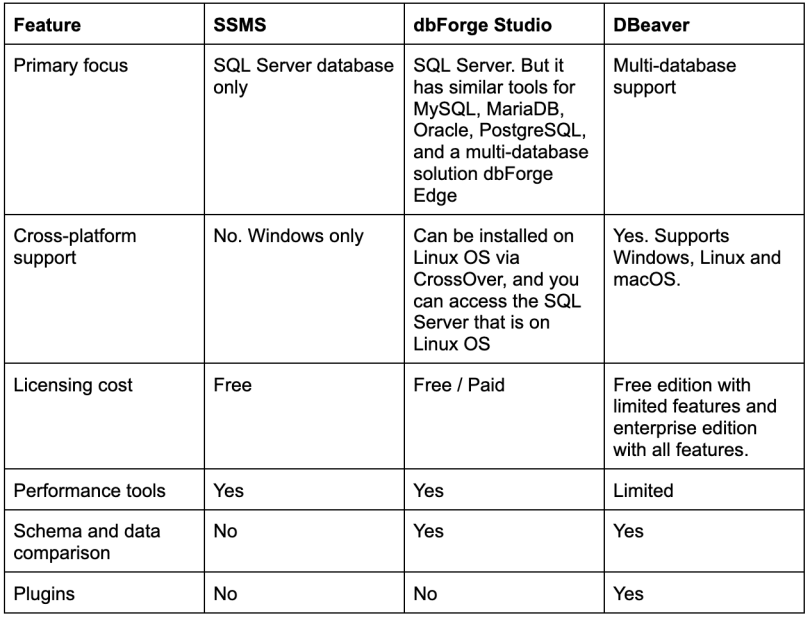SQL Server Management Studio (SSMS) is a Microsoft product that database administrators use to manage and sometimes monitor the database performance of SQL Server. SQL Server is doubtless robust, with many features like maintenance plans, SQL Server agent jobs and user-friendly UI. But it still has a few limitations.
The recent versions of SQL Server Management Studio are becoming resource-intensive because of new features. Sometimes, the SQL Server Management Studio becomes irresponsive due to a lack of resources (CPU and memory). Also, though Microsoft SQL Server is supported by Linux, we can’t install SSMS on Linux. Microsoft added many new features, like visual reports, live query execution plans, query store, and other features, but the look and feel of SSMS is still old-school.
In this article, we will explore some tools that can be potential alternatives to SQL Server Management Studio.
SSMS Alternatives
- dbForge Studio
- Azure Data Studio
- DBeaver
Best Alternatives to SSMS for SQL Server Management
As we know, managing production databases is crucial for database administrators. Similarly, writing code effectively and quickly is also important for developers. With this in mind, we’ve found three effective tools: dbForge Studio for SQL Server, Azure Data Studio, and DBeaver.
These tools have modern capabilities, cross-platform support and features that increase the productivity of both database administrators and database developers.
Now, let’s explore these tools. I’ll cover both the advantages and the drawbacks of each one, which will help you to determine the best tool that can be suitable for your organization and fulfill the requirements.
dbForge Studio for SQL Server
dbForge Studio for SQL Server is a robust and feature-rich tool developed by Devart. The dbForge Studio has many features that help DBAs and developers to manage databases. It helps database developers to reduce the effort that goes into coding and increase productivity. Despite this, it has limited functionalities for database administrators.
Key Features of dbForge Studio
SQL Development
dbForge Studio for SQL Server has an advanced autocomplete, which surpasses the IntelliSense of SSMS. It has many additional features that help developers to reduce the time spent in coding. The smart code completion feature has context-sensitive code suggestions that are very helpful to develop stored procedures and functions. It suggests not only the table name but also the column name and their data types. Also, it suggests the entire join … on … clause, including the matching columns of the tables that we are joining.
Database Administration
dbForge Studio for SQL Server also has some features that help DBAs to monitor the performance of server, backup and restore the database, index maintenance and manage database security.
One of my favorite features is find invalid objects in the database. It helps to identify the orphan stored procedures and functions. Suppose you have created a stored procedure that uses a table named tblEmployee. If we delete the table, the stored procedure will be invalid, and it will return an error at the execution stage of the stored procedure. dbForge Studio helps to find such objects.
Schema and Data Comparison and Synchronization
dbForge Studio can perform schema and data comparison. The schema and data synchronization process is crucial. Suppose you have an application that multiple clients use, and you roll out a feature in an application that uses some new tables and procedures. Due to deployment errors, some scripts failed to execute on certain client databases, which will cause an outage.
So, you should keep a process that validates and synchronizes the schema across all client databases. In such cases, the schema comparison and synchronization feature of dbForge Studio can be very helpful. It can be a good alternative to transactional replication. Suppose your requirement is to synchronize the data across multiple databases. In that case, you can use the data synchronization feature without implementing the complex SQL Server replication process.
Query Optimization
dbForge Studio is capable of running a profiler trace, which is used to monitor and troubleshoot the long running resource intensive queries. Like SQL Server Management Studio, it can show the estimated, actual, and live query plans that help to diagnose the poor performing queries.
Automation
The dbForge Studio has some basic capabilities that help to automate certain tasks like generating documentation and test data as well as data export/import. Also, it can automatically generate database performance reports. We can also setup DevOps automation (Azure DevOps, Jenkins, Bamboo etc.) using the dbForge Studio
Advantages of dbForge Studio
- It has a comprehensive suite of tools for both developers and DBAs.
- It has advanced debugging and troubleshooting capabilities.
- It integrates with source control systems like Git and SVN version control systems for collaborative workflows.
- It has a free version, the dbForge Studio for SQL Server Express edition, which is suitable for small companies or freelancers.
Drawbacks of dbForge Studio
- It is Windows-only software. You can install it on a Windows machine and connect it to SQL Server on a Linux database, however. You can also install this tool on MacOS or Linux via CrossOver and Wine.
You can download the Express edition of dbForge Studio for SQL Server here.
Azure Data Studio
Azure Data Studio is developed by Microsoft and can be one of the best alternatives to SSMS. Unlike SSMS, it does not offer a lot of features but has adequate functions like IntelliSense, which can help DBAs to work efficiently. Most importantly, it has cross-platform support, meaning you can install Azure Data Studio on Windows, Linux, and macOS. It’s a light-weight tool, so you can install it directly on the database server without impacting its performance.
Key Features of Azure Data Studio
Notebooks
In Azure Data Studio, you can combine SQL queries, text and visualization in notebooks which helps DBAs and developers to explore the data and documentation of the query.
Widgets and Extensions for Monitoring
It supports a lot of widgets and extensions that help to monitor database performance. You can create a custom matrix and monitor the entire server’s performance. You can also set certain matrices like IO performance, memory pressure and TempDB contention.
Git Compatible
You can use it with Git for efficient version control of database objects.
Advantages of Azure Data Studio
- It is lightweight and faster than SQL Server Management Studio.
- You can install it on a Windows or Linux operating system where SQL Server is installed.
- The tool is customizable because it supports various widgets and extensions.
- Like SSMS, it is free.
Drawbacks of Azure Data Studio
- You cannot create or modify SQL Server agent jobs.
- Unlike SSMS and dbForge Studio, it does not have advanced features, so it does not provide a lot of value to developers.
You can download and install the Azure Data Studio from here.
DBeaver
DBeaver is a powerful, open-source database management GUI. It supports various database systems and can be installed on Windows, macOS and Linux, makes it very useful to the developers, DBAs, and data analysts. The DBeaver has a Community edition and Professional edition. The Community edition is free, so it lacks some key features. The SQL editor in the free version covers a lot of functions, however, which can make the developer’s life easy.
Key Features of DBeaver
Platform Support
It supports various database platforms like SQL Server, Oracle, MySQL and MariaDB. Also, it can be used on Windows, Linux and macOS.
Advanced SQL Editor
It has an advanced SQL editor that has many features like syntax highlighting, auto-completion and various query debugging tools.
Simple ERD Creation
It has tools that can help database architects to create an entity relationship diagram (ERD), which can be used to manage and visualize the database schema.
Data Visualization Tools
It has built-in charting and data visualization tools that help to view and edit the data.
Advantages of DBeaver
- It supports a variety of databases like SQL Server, Oracle, MariaDB etc. Also, it can be installed on Windows, macOS and Linux.
- It has a feature-rich UI and advanced SQL query editor. It also supports visual query builder and ER diagrams.
- You can add more features to it by adding third-party plugins and extensions.
Drawbacks
- Like SQL Server Management Studio, it is resource intensive, and it might cause performance issues. This is especially true for large databases.
- It is more complex than SSMS and Azure Data Studio. Developers who are already using SSMS will face some difficulties while getting familiar with the tool.
You can download the Community edition of DBeaver from here.
Which Database Management Tool Is Right for You?
Now, let us summarize the features of SSMS, dbForge Studio, and DBeaver to understand what features they offer. This will help you to determine which tool fits your business requirements.

Finding the Right SSMS Alternative for Your Needs
If you’re looking specifically for SQL Server or Azure SQL database and don’t want to impact the performance of the database server, choose Azure Data Studio. If you’re looking for the tools to improve productivity of development tasks and basic administrative work for your database server, go for dbForge Studio for SQL Server. If you’re working in an organization that uses different RDBMS and NoSQL databases, go for DBeaver. Note that all tools have their trial versions available on their websites, so before investing, try them out and decide which tool fulfills all business requirements.





